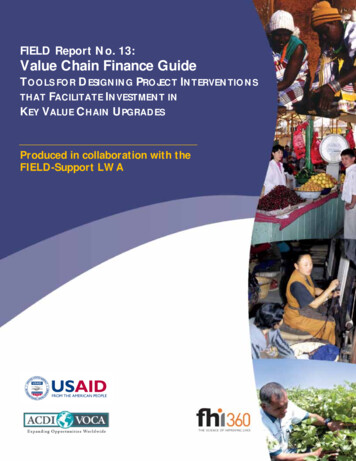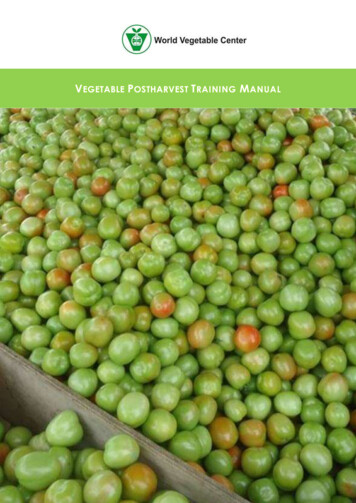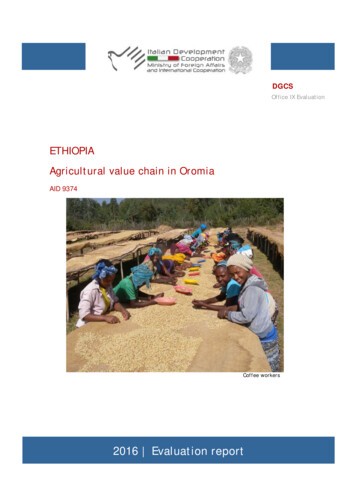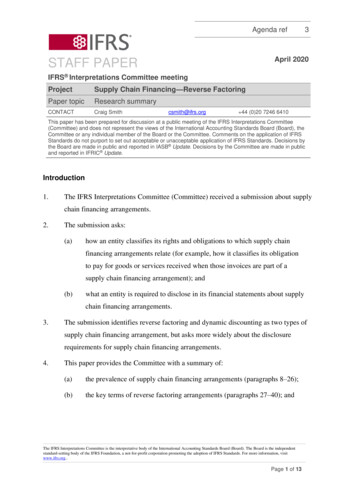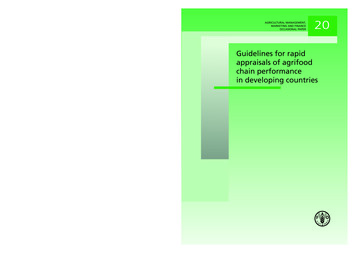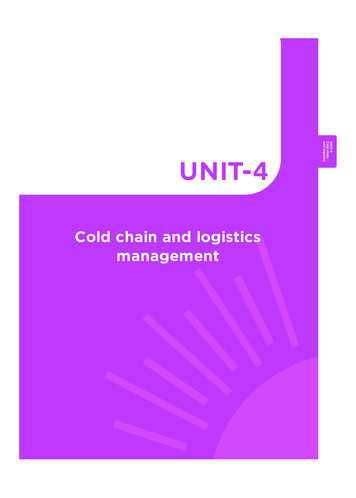
Transcription
Chartered Institute ofManagement AccountantsVALUE CHAINFINANCING INAGRICULTUREThe case of ZambiaCIMA ExecutiveSummary ReportVolume 12Issue 5
KEY CONCLUSIONS Value chain financing (VCF) is a viable modelto improve access to agricultural finance forsmallholder farmers in Zambia based onthe findings of the three case studies. The benefits of the VCF approach includeinter alia: an increase in smallholder farmers’productivity, improvement in the financialwellbeing of the farmers, and expansion ofthe agricultural production, which in turnwill lead to a higher level of food security. The challenge of offering agricultural creditthrough the value chain principle include whatcan be described as moral risk, i.e. the risk ofsmallholder farmers selling their produce andobtaining cash, but failing to settle their loaninstalment and thereby not honouring thecontract with the commercial bank.
1ABSTRACTSmallholder farmers in Zambia comprise85% of the farming community.Such farmers are not regarded as creditworthy and theiragricultural activity is characterised by low yields in production.The aim of this study is to investigate whether VCF could offerincreased access to agricultural finance for Zambian smallholderfarmers. Such financing will act as an enabler to mechanisationof the farming operation and in turn improve productivity.This study investigated and documented three independentcase studies representing practical examples of VCF appliedwithin the Zambian smallholder agricultural sector.Each case study highlights the benefits of a value chain approachfor providing finance but also emphasise certain challengesand risks associated with the approach. It was found that theVCF approach will improve the access to agricultural financefor Zambian smallholder farmers. It is recommended thatinvestors, financiers and policymakers consider both thebenefits and challenges with offering finance solutionsfollowing a VCF approach.CONTENTS2OVERVIEW OF THE PROJECT3RESULTS AND THEIR IMPLICATIONS5CONCLUSION AND RECOMMENDATIONS7NOTES
VALUE CHAIN FINANCING IN AGRICULTUREOVERVIEW OF THE PROJECTAfrica is the continent that has to feed the world. The continenthas more than a quarter of the world’s total arable land availableand an abundance of natural resources.According to a recent report by the Food and Agricultural Organization(FAO) on food insecurity in Africa (2015), priority must be given toeconomic growth in the agricultural sector. The sector has the potentialto provide a stable food supply at affordable prices, which, in turn,contributes to the competitiveness of the economy. The FAO (2012)highlights that agricultural investment is an effective way to i) reducepoverty, ii) promote agricultural productivity, and iii) enhanceenvironmental sustainability. Additionally, food production in SubSaharan Africa (SSA) is not keeping up with population growth. Althoughcrop yields in the developed and developing world have steadilyincreased over the last 50 years, yields in Africa have generally remainedat approximately one ton/hectare or even less (Tittonell & Giller, 2013).An opportunity exists to close this yield gap by improving productivity.In Africa, 70% of the food supply is produced by smallholderfarmers; in other words, they generally produce staple foodsenough for own use with occasional marketable surplus. Moreover,the agricultural sector in Africa provides employment to more than80% of the population (IFAD and UNEP, 2013). A renewed focus onthe investment needs and developmental support of smallholderfarmers is therefore critical (IFAD and UNEP, 2013). Oberholster,Adendorff and Jonker (2015) concur by adding that agriculture-ledgrowth can be effective in reducing poverty when making use ofappropriate financing solutions that include smallholder farmers.Zambia is a country with the potential to contribute to providingglobal food security. It is located in SSA with the agricultural sectorcontributing an estimated 10.8% to the country’s gross domesticproduct (GDP) in 2014. Zambia has achieved an annual averageGDP growth rate of 6.7% over the last ten years. According to theZambian Ministry of Agriculture and Co-operatives, smallholderfarmers comprise 85% of the farmer population and cultivate lessthan five hectares (ha). The smallholder farmers face a number ofchallenges in their financing. From a financier’s viewpoint,agricultural investment in general is perceived as high risk due to 1)price risk, 2) climate risk, and 3) credit risk. However, thesmallholder agricultural sector in SSA is also characterised by lowproductivity (low yields) and low mechanisation. As commercialbanks struggle to finance smallholder farmers, there is a need for acommercial financing solution inclusive of smallholder farmers.Collateral is a key ingredient in lending, especially by commercialbanks providing agricultural financing. Traditionally, in agriculturallending, agricultural land is the key form of collateral. However, theagricultural land in Zambia is government owned and thoseinterested in land obtain it on lease for a period of 99 years throughthe Ministry of Lands. Smallholder farmers as such are regarded asnot creditworthy by commercial banks as the risk of non-repaymentis high and, in the event of default, offers no collateral. Theaforementioned challenges lead to increased risk exposure for thefinancier of such an investment and if credit is granted, very highinterest rates and strict credit terms are levied to compensate forthe high risk. From the smallholder farmers’ point of view, it is arequirement to obtain affordable financing at realistic credit terms.It can therefore be reiterated that there is a need for new andinnovative agricultural financing solutions that are commerciallyviable for both the financier and the smallholder farmer.Within this context, value chain financing (VCF) was investigatedas a solution for increased access to agricultural financing forsmallholder farmers in Zambia.OBJECTIVESThe objectives of the research were: to define and contextualise value chain financing for theagricultural sector within an African-wide context from availableliterature; to identify and document a number of existing agricultural valuechain financing case studies in Zambia; and to recommend improvements to the existing agricultural valuechain financing concept in Zambia.
FOR MORE INFORMATION VISIT WWW.CIMAGLOBAL.COM2/3RESULTS ANDTHEIR IMPLICATIONSThe first objective of contextualising VCF for the agriculturalsector is addressed below.CONTEXTUALISING VALUE CHAIN FINANCINGThe theoretical concept of value chain was coined by MichaelPorter in 1985 (Porter, 1985). VCF comprises the flow of creditbetween any or all of the agricultural finance providers, productsand support services among the various value chain actors (Miller& Jones, 2010). Agricultural value chains that function optimallymake use of financial products that meet specific needs. The creditrisk is furthermore significantly reduced by the techniques used todistribute and collect funds (Oberholster et al., 2015). It is criticalfor the success of VCF that an effective lead chain actor isidentified (Miller, 2010; Greenberg, 2010). Agribusinesses can act asan effective lead actor as: 1) they have an extended rural footprint,and 2) they have close relationships with their customers. Thisallows for a hands-on approach in managing the VCF credit risk.The relationship between the lead chain actor and the smallholderfarmer can play an important role in facilitating access to financialservices (Oberholster et al., 2015).Some of the benefits that an agricultural VCF offers to smallholderfarmers include the reduction of the cost and risk in financing. Itfurthermore offers a mechanism to improve the access to financingfor smallholder farmers that, due to 1) a lack of collateral, or 2) thehigh transaction costs of securing a loan, may otherwise not beavailable (Miller & Jones, 2010).EXISTING VCF CASE STUDIESThis study investigated and documented three independent casestudies representing practical examples of VCF applied within theZambian smallholder agricultural sector. Each case study representsa different lead chain actor with varying objectives for acquiringfinance for smallholder farmers. The benefits and challenges thatVCF brings to each case study were investigated. In this executivesummary, a detailed discussion of the first case study, titled“Promoting conservation farming” is presented. The full paper canbe accessed by contacting the author.Promoting conservation farmingThe lead chain actor in this case study is the Conservation FarmingUnit (CFU). CFU is a non-profit organisation with the key aim ofpromoting ‘climate smart’ agriculture. CFU is funded by theNorwegian government and has been operating in Zambia foralmost two decades. The organisation offers free training inconservation farming (CF) practices.In Zambia, relatively few tractors are utilised by smallholderfarmers for ploughing and haulage, as the land is mostly preparedusing oxen or through manual labour. CFU envisioned that if thefarmer could switch from manual labour to using a tractor andripper for ploughing and haulage, the area forged according to‘climate smart’ principles would be expanded and productivitywould increase. CFU therefore realised that by mechanising theagricultural production process, it could be achieved. A need forfinancing to mechanise the agricultural production process amongsmallholder farmers was therefore identified by CFU.However, as described before, commercial banks are reluctant tooffer credit to smallholder farmers and as such an alternativefinancing solution was required. The VCF was therefore put intopractice. CFU was identified as the lead chain actor with numerousfield officers working closely with the smallholder farmers andhaving a well-established rural footprint.CFU, as the lead chain actor, therefore approached the Zambianbranch of a South African commercial bank (refer Figure 1) forfunding of these smallholder farmers. Based on the relationshipbetween CFU and the smallholder farmers, the commercial bankagreed to finance the latter. The repayment obligation, however,remains with the individual eligible smallholder farmer. As strongrelationships have been formed between the CFU’s fieldworkersand the smallholder farmers, the fieldworkers assist the farmers inpreparing credit applications. The fieldworkers are also responsiblefor the initial credit vetting of the farmers. The ultimate decisionon the granting of credit, however, lies with the commercial bank’scredit department.The size of the loan is large enough to purchase a tractor and aripper and the loan is repayable within three to four years. Thefarmer is required to pay a deposit of 20% on the value of theequipment. As part of the purchase agreement, the tractor providerhas to offer an after-sales service and the farmer is furthermorerequired to take out insurance on the equipment. As smallholderfarmers traditionally lack collateral, this scheme has beenstructured such that the equipment serves as collateral. In case thesmallholder farmer defaults on the loan payment, the commercial
VALUE CHAIN FINANCING IN AGRICULTUREbank can repossess the tractor and ripper. The smallholder farmersuse the income generated by the enhanced agricultural productionto pay the instalments on the loan.The VCF participants in this case study are 1) the CFU, 2) theZambian branch of a commercial South African bank, 3)smallholder farmers in Zambia, and 4) various input suppliers,including tractor, insurance and production inputs.This case study is a good practical example of agricultural VCF. Theindividual smallholder farmer would not have qualified for a loan ifit were not for the relationship with the CFU. The benefits of theVCF transaction are widespread. Firstly, the smallholder farmer’sproductivity is greatly increased: i) better yields are achieved, ii)better quality crop is grown as planting and harvesting can be doneat the right time, and iii) planting and harvesting time is reducedwith less waste due to planting and harvesting at the right time.Secondly, the farmer’s financial wellbeing is improved on twolevels: the tractor and ripper are income-generating assets. Thefarmer can provide land preparation services to surroundingfarmers to generate income, which, in turn, would benefit thesurrounding farmers in terms of increased productivity.Furthermore, as a result of the increased productivity, the farmer’sprofit would rise, which could lead to an expansion of the areaunder agricultural production. Thirdly, the sustainability of theagricultural land is greatly enhanced by following the CF practicestaught by the CFU. These practices lead to better soil conservation,which, in turn, reduces the effects of climate change.Lastly, the social consequence of the VCF transaction is distinct.The direct effect of a farmer owning a tractor and, in turn, using itto improve the livelihood of the surrounding farmers in thecommunity is that his social standing in the community iselevated. Furthermore, less manual labour would be required by thefarmer. As the children of smallholder farmers are generallyincluded in the manual labour tasks, these children would be freeto attend school and further their education. In addition, the localeconomy is boosted with these individuals increasing theirspending as a result of the increased profits. Another indirectimpact of the CFU initiative is increased employment. As thefarmer (and surrounding farmers) shifts from a smallholder farmerto a medium-scale farmer, the need for more inputs, transport tothe markets and seasonal harvesters also increases, leading tohigher employment. Furthermore, as the farmer expands the areaunder cultivation, more arable land is utilised, leading to theoptimal use of available arable land in Zambia.The challenges, on the other hand, of offering agricultural creditthrough the value chain principle can be described as moral risk.This risk includes smallholder farmers selling their produce andobtaining cash, but fails to settle their loan instalment and therebynot honouring the contract with the commercial bank. However, asowning a tractor elevates a smallholder farmer’s social standing,the loss of a tractor due to repossession by the commercial bankgreatly reduces this risk. Another challenge is to expand thisoffering as currently a limited number of smallholder farmers meetthe required qualifications and are accepted onto this actor COMMERCIAL BANK – LIERDEPOSITFIGURE 1: PROMOTING CONSERVATION FARMING – VALUE CHAIN PARTICIPANTS
FOR MORE INFORMATION VISIT WWW.CIMAGLOBAL.COMCONCLUSION ANDRECOMMENDATIONSIt can be concluded that VCF is a viable model to improve accessto agricultural finance for smallholder farmers in Zambia.The recommended improvements to the existing VCF conceptinclude: Training to heighten financial interest could be provided to thesmallholder farmers; Sensitising financiers to both the benefits and challenges whenusing the VCF model in financing smallholder farmers; Governmental assistance in terms of grants available fordeposits when using the funds for mechanisation; and Restricting the interest rates charged by banks when offeringagricultural credit for mechanisation.In conclusion, it can be emphasised that over the long term thebenefits of applying VCF in financing smallholder farmers wouldlead to increased food security and accelerated economic growthfor Zambia. As not all available arable land is currently utilised inZambia, the increased productivity due to mechanisation wouldultimately lead to an increased use of land.4/5
VALUE CHAIN FINANCING IN AGRICULTUREREFERENCES AND FURTHER READINGCIA World Factbook. 2015. Zambia. -factbook/geos/za.html Date of access: 18Jul. 2015.FAO, 2012. The state of food and agriculture: Investing in agriculturefor a better future. FAO, Rome.FAO, 2015. Regional overview of food insecurity: African foodinsecurity prospects brighter than ever. FAO, Accra.Greenberg, S. 2010. Status Report on Land and Agricultural Policy inSouth Africa, 2010. Institute for Poverty, Land and Agrarian Studies,School of Government, University of the Western Cape, Cape Town,South Africa.IFAD & UNEP. 2013. Smallholders, food security and theenvironment. International Fund for Agricultural Development,Rome.ACKNOWLEDGEMENTSThe author gratefully acknowledges the Chartered Institute ofManagement Accountants’ (CIMA) Centre of Excellence South Africafor providing the financial support to carry out this investigation.AUTHORSanlie MiddelbergAssociate Professor of Management AccountingNorth-West University, Potchefstroom, South AfricaE: sanlie.middelberg@nwu.ac.zaT: 27 18 2994428REFERENCES AND FURTHER READINGMiddelberg, S.L. 2016. Value-chain financing: A viable funding modelfor businesses expanding into Africa. Financial Management, Apr., 14.Middelberg, S.L. 2016. How small-scale farmers in Zambiaare benefiting from value-chain financing. Financial Management,Aug., 14.Miller, C. & Jones, L. 2010. Agricultural value chain finance: Tools andlessons. FAO, Rome.Miller, C. 2011. Agricultural value chain finance strategy and design.Technical Note, FAO, Rome.Oberholster, C., Adendorff, C. & Jonker, K. 2015. 2015. Financingagricultural production from a value chain perspective: Recentevidence from South Africa. Outlook on Agriculture, 44:49-60.Porter, M.E. 1985. Competitive advantage. The Free Press, New York.Tittonell, P. & Giller, K.E. 2013. When yield gaps are poverty traps:The paradigm of ecological intensification in African smallholderagriculture. Field Crops Research, 143:76-90.
FOR MORE INFORMATION VISIT WWW.CIMAGLOBAL.COMNOTES6/7
Chartered Institute ofManagement AccountantsThe HeliconOne South PlaceLondonEC2M 2RBUnited Kingdomcima.contact@cimaglobal.comISSN Number 1744-7038October 2016 The Chartered Institute of Management Accountants 2016
to define and contextualise value chain financing for the agricultural sector within an African-wide context from available literature; to identify and document a number of existing agricultural value chain financing case studies in Zambia; and to recommend improvements to the existing agricultural value chain financing concept in .
